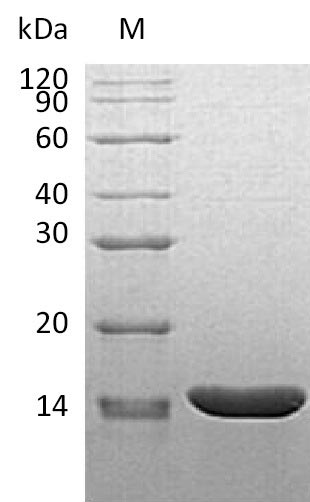Recombinant Mouse Tumor Necrosis Factor (Tnf) is produced in E. coli and comprises a partial sequence of amino acids 89 to 235. This tag-free protein demonstrates a purity greater than 95% as confirmed by SDS-PAGE analysis. It exhibits biological activity with an ED50 of 2-8 pg/ml in a cytotoxicity assay using L929 mouse fibroblast cells, alongside actinomycin D. The endotoxin level is maintained below 1.0 EU/µg as determined by the LAL method.
Tumor necrosis factor (TNF) appears to be one of those pivotal cytokines that somehow manages to wear many hats in the immune system. It's deeply involved in systemic inflammation and serves as part of the body's acute phase response. TNF plays what seems to be a crucial role in regulating immune cells, inducing fever, triggering apoptotic cell death, and inhibiting both tumorigenesis and viral replication. Given its broad influence, TNF has become integral to research spanning immunology, cancer studies, and various inflammatory diseases—making it a significant target for therapeutic research and drug development.
Potential Applications
Note: The applications listed below are based on what we know about this protein's biological functions, published research, and experience from experts in the field. However, we haven't fully tested all of these applications ourselves yet. We'd recommend running some preliminary tests first to make sure they work for your specific research goals.
1. Cytotoxicity Assays for TNF-α Research
This recombinant mouse TNF is confirmed to be highly biologically active (ED₅₀ 2-8 pg/ml in L-929 cells) and suitable as a positive control in cytotoxicity assays. However, the partial sequence (89-235aa) may not fully represent the full-length TNF, potentially affecting some biological functions such as receptor clustering or signaling amplitude. Researchers should validate that cell death mechanisms (e.g., apoptosis vs. necroptosis) match those induced by full-length TNF in their specific cell models. The high potency supports reliable dose-response studies, but optimal concentrations may need adjustment for different cell types.
2. In Vitro Inflammatory Response Studies
The biologically active TNF is appropriate for inflammatory studies, but the E. coli expression produces a non-glycosylated protein, which may alter stability or signaling kinetics compared to native glycosylated TNF. Researchers should confirm that inflammatory responses (e.g., NF-κB activation, cytokine production) are consistent with full-length TNF, particularly in long-term assays where protein half-life matters. The low endotoxin ensures specific attribution of effects to TNF activity.
3. Antibody Development and Validation
This high-purity, tag-free TNF serves as a good antigen for antibody development. However, antibodies generated against this partial sequence will not recognize epitopes in the missing N-terminal region (aa 1-88). Comprehensive validation should include testing against full-length, mammalian-expressed TNF to ensure recognition of all functional domains and glycosylated forms. The confirmed bioactivity supports the development of function-blocking antibodies, but epitope coverage may be incomplete.
4. Protein-Protein Interaction Studies
The biologically active TNF is suitable for interaction studies with TNF receptors, but the partial sequence may lack domains involved in some interactions, such as those requiring the full extracellular domain. Researchers should validate novel interactions with full-length TNF to ensure biological relevance. The tag-free design ensures authentic binding without interference, but the E. coli expression may affect interactions dependent on glycosylation.
5. Preclinical Research Model Development
This TNF can be used in preclinical models, but the E. coli expression and partial sequence may affect in vivo stability and immunogenicity, potentially leading to rapid clearance or immune responses. Researchers should validate that effects in animal models match those induced by full-length, mammalian-expressed TNF, particularly for chronic studies where protein persistence is important. The low ED₅₀ indicates high potency, but in vivo dosing may require optimization.
Final Recommendation & Action Plan
This recombinant mouse TNF partial protein (89-235aa) expressed in E. coli demonstrates exceptional potency (ED₅₀ 2-8 pg/ml) and is suitable for in vitro applications such as cytotoxicity assays and inflammatory studies, but its partial nature and lack of glycosylation necessitate validation for each specific use. For immediate use, employ it at picogram-level concentrations based on the ED₅₀, but establish dose-response curves in your specific cell systems to account for potential variations. When developing antibodies, this protein is ideal for generating reagents against the C-terminal region, but validated against full-length TNF to ensure comprehensive epitope coverage. For interaction studies, the tag-free design is advantageous for receptor binding assays, but confirm key findings with a full-length protein. In preclinical models, exercise caution due to potential immunogenicity and prefer mammalian-expressed TNF for long-term studies. Always include appropriate controls (e.g., full-length TNF when available) and acknowledge that the partial sequence may not fully recapitulate all functions of native TNF.






